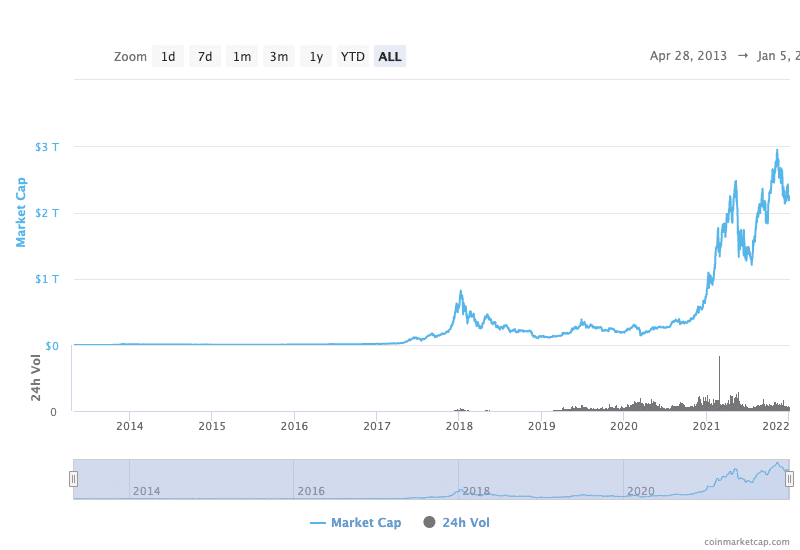Originally published in Traders Magazine
By Joe Schifano, Global Head of Regulatory Affairs, Eventus
2021 was another record year for cryptocurrency trading. But it will be remembered as the year the industry saw considerable strides in regulatory advancement.
Cryptocurrency volumes rose significantly during 2021, building on a strong 2020. It was a positive year for the industry, largely due to increased regulatory development and greater institutional adoption of digital assets.
Accelerated by an uptick in cross-border payments and retail trading, the market capitalization of cryptocurrencies soared to a peak of $3 trillion – more than four times its value at the close of 2020 – with daily traded volumes reaching over $275 billion on over 400 global trading venues.
Total Cryptocurrency Market Capitalization

As we approach 2022 with the expectation of further growth, let’s look back at the leading indicators from 2021 – first through the lens of global regulators, followed by the response from exchanges and market participants.
Predictable growth, unpredictable regulation
In Europe, we started the year with a seasonal gift from the European Commission (EC). The Markets in Crypto Assets (MiCA) proposal paper outlined the Commission’s plan “to make Europe fit for the digital age” and sent a strong message about the desire to “instil appropriate levels of consumer and investor protection and market integrity given that crypto-assets [are] not covered by existing financial services legislation.”
Within it, Article 76 defines the scope of the proposed market abuse rules, outlining how crypto-asset service providers should surveil for potential market abuse committed by clients. This is the start of a 24-month legislative process to enact the proposed regulation, as outlined in Eventus’ article “Crypto Surveillance – Regulators take digital assets seriously.”
The Commission’s aim with this proposal is to prevent regulatory divergence among the member states, explained EC Advisor Peter Kerstens at Eventus’ mid-year “Shining a Light on Digital Asset Markets 2021” (SAL 2021) conference in this Highlights piece.
The same conference saw SEC Commissioner Hester Peirce and CFTC Commissioner Dawn Stump outline the US’ stance on crypto regulation. Both regulators were focused on information gathering at this stage, with Peirce expressing some concern that crypto regulation had not yet made the SEC’s agenda. As the year closed, differing opinions culminated in tensions at meetings of the SEC Investor Advisory Committee, albeit with agreement that gaps in investor protection must be addressed. As Chairwoman Waters reiterated at the House Financial Services Committee hearing in December, despite the numerous regulatory touchpoints, from state regulators to the OCC and Fed, there is no overarching or centralized regulatory framework for crypto, leaving the potential for manipulation and fraud. Further afield, Hong Kong is allowing virtual asset venues to apply for Securities and Futures Commission (SFC) licences to trade, and Singapore has temporarily permitted a number of firms to operate under the Payment Services Act, with both regimes making it clear that surveillance is a top priority. Our article “What is the regulatory outlook for virtual asset exchanges in Hong Kong and Singapore?” contains more detail.
Markets read the sentiment
Over the past year, the major global crypto exchanges have learned that offering services to a geographically distributed client base in the long term will require adherence to the strictest of the world’s regulatory regimes.
So, despite differing attitudes from global policymakers in 2021, the crypto markets have heeded the overall sentiment and trajectory of regulatory concerns, and the year saw a significant rise in engagement from surveillance teams as a result.
FTX US was one of the many crypto exchanges to turn to Eventus in the last year, choosing the high-performance and flexible Validus platform to prepare for the regulatory journey ahead.
Latecomers to the party, the more traditional markets began to increase their focus on this asset class in the final quarter of 2021, giving us a sneak preview of an exciting year to come. In October, Cboe Global Markets’ acquisition of digital asset spot market ErisX paved the way for an acceleration in digital asset trading.
Similarly, Marex Solutions’ partnership with Coinbase Prime could boost adoption of digital hedging and crypto investment in 2022.
A-Team Group’s webinar “The Emerging Market Structure for Institutional Trading of Digital Assets” in late November offered a platform to reflect on the momentum and regulatory developments of 2021. The panel observed that the oversight and institutionalization of digital assets “must be informed by the lessons learned from traditional finance and existing regulatory guidance.” And as Eventus’ Chief Product Officer Ollie Cadman explained, “Where regulation is uncertain, flexibility is key.”
2022 and beyond
The trends of the final few months of 2021 bode well for 2022. We can expect a lot of activity in the U.S., as anticipated in recent congressional hearings, and we predict that crypto venues will place a continued focus on trade surveillance, particularly as global regulators better define their requirements. Once that happens, a second wave of crypto adoption will follow.
One thing is certain: 2022 will be a busy year.
